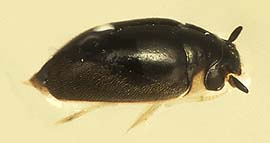Spanglerogyrus albiventris
| Spanglerogyrus albiventris | ||||||||||||
|---|---|---|---|---|---|---|---|---|---|---|---|---|

Spanglerogyrus albiventris |
||||||||||||
| Systematics | ||||||||||||
|
||||||||||||
| Scientific name of the subfamily | ||||||||||||
| Spanglerogyrinae | ||||||||||||
| Folkerts , 1979 | ||||||||||||
| Scientific name of the genus | ||||||||||||
| Spanglerogyrus | ||||||||||||
| Folkerts , 1979 | ||||||||||||
| Scientific name of the species | ||||||||||||
| Spanglerogyrus albiventris | ||||||||||||
| Folkerts , 1979 |
Spanglerogyrus albiventris is a species of the tumbler beetle (family Gyrinidae) from North America.
features
The species reaches a body length of almost 3 millimeters and a width of about 1.5 millimeters, making it one of the smallest tumbler beetles. The body outline is elongated, oval, convex, and somewhat flattened dorsoventrally (from top to bottom). It is predominantly black in color with an inconspicuous, metallic bronze sheen. The sides of the pronotum , a narrow marginal strip of the elytra , the underside of the head (except for the genae ), the mouthparts with the exception of the mandibles and the underside of the trunk section, and the epipleurs are set off in yellowish white . The ventral side of the abdomen is yellowish white only in the females, in the males it is brown.
On the head, the complex eyes , which are divided, as is typical of the tumbler beetles, are only separated from each other by a narrow ridge; the two parts are not, as with all other tumbler beetles, widely separated from each other. The antennas are short cylindrical and rounded at the end, they consist of 9 segments. The scutellum is present and triangular in shape. The cover wings have neither clear impressions nor rows of points. At the end they are truncated and somewhat shortened, the tips are elongated in the female, and in the male they are edged without any extension. As with the pronotum, they are coarsely hairy on the back on the outside. The hind wings are long (macropter), the beetles are presumably capable of flight. The legs are transformed into swimming legs, but less prominent than in the other tumbler beetles. The fore legs are not flattened, the middle and rear legs are flat with an oval outline. The rails of the middle and rear legs are also flattened and about four times as long as they are wide. Their tarsi are somewhat flattened but not broadened, their limbs are about as wide as they are long. Six abdominal segments can be seen on the abdomen , the last two are fused.
The larvae of the species are unknown.
Ecology and way of life
Spanglerogyrus albiventris lives in the bank zone of shaded rivers of moderate size (about 7 to 10 meters wide). Steep bank banks are settled, often undercut by the current, where the roots of bank trees are mostly exposed. The species is rare in populated habitats; other tumbler beetle species in the same habitat are Gyretes sinuatus and Gyrinus marginellus . The beetles move very quickly and have the ability to jump (similar to flea beetles ).
distribution
The species lives in the southwest of the USA. It was discovered in Alabama , on the coastal plain to the Gulf of Mexico . In the populated region, the Red Hills, the valleys of the streams are cut quite deeply into the plain and these have a somewhat lively relief. Other finds were later reported from Tennessee , Florida , South Carolina, and the District of Columbia . Because the species is difficult to find and little explored in its habitats, it may be more common.
Taxonomy and systematics
The species is taxonomically isolated in the family and is the only species listed in the (thus monotypical ) subfamily Spanglerogyrinae. It is morphologically characterized by numerous original ( plesiomorphic ) features, such as the still imperfectly separated eye segments, the two-segment galeae and the shape of the middle and rear legs, which are only slightly adapted to swimming ability. In a combined analysis of the phylogeny of the Gyrinidae, based on morphological features and the comparison of homologous DNA sequences, the species was the sister species of all other Gyrinidae combined.
Literature and Sources
- George W. Folkerts (1979): Spanglerogyrus albiventris, a Primitive New Genus and Species of Gyrinidae (Coleoptera) from Alabama. Coleopterists Bulletin Vol. 33, No. 1: 1-8. online at JSTOR
- RE Roughley: Family Gyrinidae. in: Ross H. Arnett, Jr. & Michael C. Thomas: American Beetles, Vol 1: Archostemata, Myxophaga, Adephaga, Polyphaga: Staphyliniformia. CRC Press, 2000. ISBN 978-0-8493-1925-9 limited preview on Google Books
Individual evidence
- ^ Gray T. Gustafson & Kelly B. Miller (2013): On the family- and genus-series nomina in Gyrinidae Latreille, 1810 (Coleoptera, Adephaga). Zootaxa 3731 (1): 77-105.
- ↑ Kelly B. Miller & Johannes Bergsten (2012): Phylogeny and classification of whirligig beetles (Coleoptera: Gyrinidae): relaxed-clock model outperforms parsimony and time-free Bayesian analyzes. Systematic Entomology 37: 706-746. doi: 10.1111 / j.1365-3113.2012.00640.x